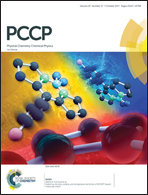Rate constants for H abstraction from benzo(a)pyrene and chrysene: a theoretical study
Abstract
Density functional B3LYP/6-31G(d) and ab initio G3(MP2,CC) calculations have been carried out to determine thermal rate constants of direct H abstraction reactions from four- and five-ring polycyclic aromatic hydrocarbons (PAH) chrysene and benzo[a]pyrene by various radicals abundant in combustion flames, such as H, CH3, C3H3, and OH, using transition state theory. The results show that the H abstraction reactions with OH have the lowest barriers of ∼4 kcal mol−1, followed by those with H and CH3 with barriers of 16–17 kcal mol−1, and then with propargyl radicals with barriers of 24–26 kcal mol−1. Thus, the OH radical is predicted to be the fastest H abstractor from PAH. Even at 2500 K, the rate constant for H abstraction by H is still 34% lower than the rate constant for H abstraction by OH. The reaction with H is calculated to have rate constants 35–19 times higher than those for the reaction with CH3 due to a more favorable entropic factor. The reactions of H abstraction by C3H3 are predicted to be orders of magnitude slower than the other reactions considered and their equilibrium is strongly shifted toward the reactants, making propargyl an inefficient H abstractor from the aromatics. The calculations showed strong similarity of the reaction energetics in different H abstraction positions of benzo[a]pyrene and chrysene within armchair and zigzag edges in these molecules, but clear distinction between the armchair and zigzag sites. The zigzag sites appear to be more reactive, with H abstraction rate constants by H, CH3, and OH being respectively 37–42%, a factor of 2.1, and factors of 8–9 higher than the corresponding rate constants for the H abstraction reactions from armchair sites. Although the barrier heights for the two types of edges are similar, the entropic factor makes zigzag sites more favorable for H abstraction. Rate expressions have been generated for all studied reactions with the goal to rectify current combustion kinetics mechanisms.



 Please wait while we load your content...
Please wait while we load your content...